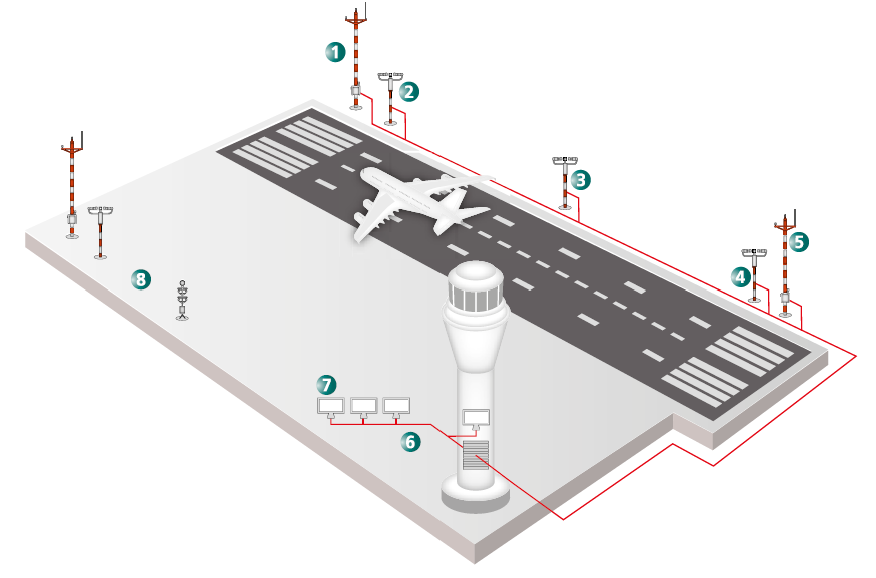The continuous growth in air traffic necessitates the expansion of airport services while upholding stringent safety standards and improving passenger experiences. Meteorological conditions, an uncontrollable factor, significantly impact airport operations. By investing in advanced meteorological sensors, airports can obtain precise, real-time weather data, enabling informed decision-making and minimizing weather-related disruptions for the aviation industry.
Runway Visual Range (RVR) and METAR:
RVR, a critical parameter for safe aircraft landings and take-offs is commonly estimated using visibility sensors. These sensors are also crucial for generating METAR and SPECI reports, which provide essential weather information to pilots and air traffic controllers.
Traditionally, transmissometers were employed for visibility measurement due to their direct measurement of the extinction coefficient. However, their limited range and high cost have led to the widespread adoption of forward scatter meters (FSMs), which offer comparable performance, extended measurement range (10m to 75km), and reduced maintenance requirements. Biral FSMs, in particular, meet or exceed ICAO (9837 and Annex 3), WMO, FAA, CAA (CAP437, CAP670, and CAP746), and CAAC requirements, with calibration traceable to a reference standard transmissometer, ensuring compliance with international aviation standards.
Present Weather Sensors and Measurement:
Present weather sensors provide detailed information on current meteorological conditions, including visibility, precipitation type (liquid or frozen), and intensity. This data is vital for METAR and SPECI reports, as well as for forecasting purposes.
To address the challenge of accurately differentiating between liquid and frozen precipitation, Biral’s FSMs utilize a unique backscatter receiver. This technology enhances precipitation classification accuracy, ensuring the correct reporting of precipitation codes even in challenging conditions, a crucial aspect for aviation safety, especially concerning aircraft and runway icing.
Ambient Light Sensor for RVR:
Accurate RVR calculation requires visibility, ambient light level, and runway light intensity data. While runway light intensity is often readily available, visibility and ambient light levels must be measured on the runway. The ALS-2 ambient light sensor, which connects directly to Biral’s VPF or SWS visibility sensors, provides both visibility and ambient light measurements in a single data message, streamlining data collection and integration.
Airfield Sensor Configuration and Maintenance:
The configuration of meteorological sensors at an airfield varies depending on its size and complexity, with no one-size-fits-all solution. Biral offers a comprehensive range of sensors, including the VPF and SWS series, with varying capabilities to cater to different airfield requirements and budgets.
These sensors are designed for reliability and longevity, incorporating features that minimize maintenance requirements. All Biral sensors are compatible with user-friendly field test and calibration kits, enabling operators to maintain high measurement confidence without the need for costly off-site calibration.

- 10m mast for wind, temperature, relative humidity and pressure sensors
- Touchdown zone: visibility and ambient light sensors
- Midpoint: visibility and ambient light sensors
- Touchdown zone: visibility and ambient light sensors
- 10m mast for wind, temperature, relative humidity and pressure sensors
- Processing of meteorological data for ATM including RVR
- Meteorological data distributed to other users
- Met garden: meteorological sensors, including BTD-300 lightning detector, for forecasts and general use
Thunderstorm (Lightning) Detection:
The BTD-300 Thunderstorm Detector, a standalone sensor, reliably detects all forms of lightning within an 83km range, exceeding FAA requirements. Its unique quasi-electrostatic operating principle ensures a low false alarm rate and the ability to warn of overhead lightning risks. The BTD-300, virtually maintenance-free, can operate as a standalone unit or integrate with other airport weather monitoring systems.
Conclusion:
Meteorological sensors are indispensable tools for ensuring safety and efficiency in airport operations. By providing accurate, real-time weather data, these sensors empower airports to make informed decisions, minimize weather-related disruptions, and uphold the highest safety standards. Biral, with its comprehensive range of certified and reliable meteorological sensors, is committed to supporting the aviation industry in achieving these goals.